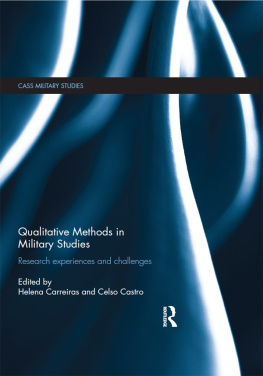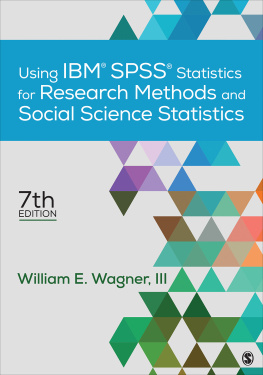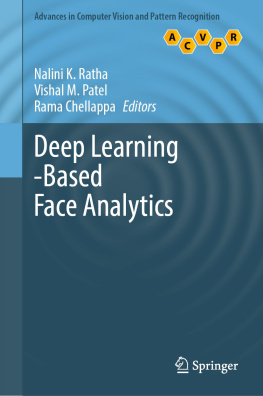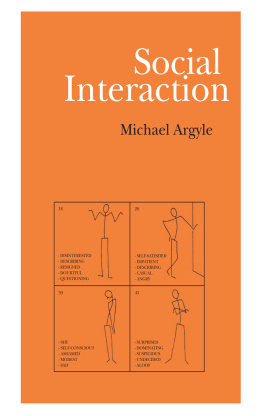ROUTLEDGE LIBRARY EDITIONS:
COMMUNICATION STUDIES
Volume 3
FACE-TO-FACE INTERACTION
Face-to-Face Interaction
Research, Methods, and Theory
Starkey Duncan, Jr. and
Donald W. Fiske
First published in 1977 by Lawrence Erlbaum Associates, Publishers
This edition first published in 2016
by Routledge
2 Park Square, Milton Park, Abingdon, Oxon OX14 4RN
and by Routledge
711 Third Avenue, New York, NY 10017
Routledge is an imprint of the Taylor & Francis Group, an informa business
1977 Lawrence Erlbaum Associates, Inc.
All rights reserved. No part of this book may be reprinted or reproduced or utilised in any form or by any electronic, mechanical, or other means, now known or hereafter invented, including photocopying and recording, or in any information storage or retrieval system, without permission in writing from the publishers.
Trademark notice : Product or corporate names may be trademarks or registered trademarks, and are used only for identification and explanation without intent to infringe.
British Library Cataloguing in Publication Data
A catalogue record for this book is available from the British Library
ISBN: 978-1-138-93903-5 (Set)
ISBN: 978-1-315-67052-2 (Set) (ebk)
ISBN: 978-1-138-95885-2 (Volume 3) (hbk)
ISBN: 978-1-315-66099-8 (Volume 3) (ebk)
Publisher's Note
The publisher has gone to great lengths to ensure the quality of this reprint but points out that some imperfections in the original copies may be apparent.
Disclaimer
The publisher has made every effort to trace copyright holders and would welcome correspondence from those they have been unable to trace.
FACETOFACE INTERACTION:
Research, Methods, and Theory
STARKEY DUNCAN, Jr.
DONALD W. FISKE
THE UNIVERSITY OF CHICAGO
DISTRIBUTED BY THE HALSTED PRESS DIVISION OF
JOHN WILEY & SONS
New York Toronto London Sydney
Copyright 1977 by Lawrence Erlbaum Associates, Inc.
All rights reserved. No part of this book may be reproduced in any form, by photostat, microform, retrieval system, or any other means, without the prior written permission of the publisher.
Lawrence Erlbaum Associates, Inc., Publishers
62 Maria Drive
Hillsdale, New Jersey 07642
Distributed solely by Halsted Press Division
John Wiley & Sons, Inc., New York
Library of Congress Cataloging in Publication Data
Duncan, Starkey.
Face-to-face interaction.
Bibliography: p.
1. Interpersonal communication. I. Fiske, Donald Winslow, 1916 joint author. II. Title.
BF637.C45D86 301.4 77-1841
ISBN 0-470-99113-5
Printed in the United States of America
To Our Families
Contents
FACETOFACE INTERACTION:
THE RESEARCH AREA AND SOME BASIC ISSUES |
|
Measurement Techniques and Research
Strategies |
A Study of Individual Differences in Five-Minute
Interactions |
Descriptive Statistics and Group
Differences |
|
|
Actions, Self-Descriptions,
and Reactions |
|
|
STUDIES OF THE ORGANIZATION OF FACETOFACE
INTERACTION |
|
A PROPOSED METATHEORY AND
RESEARCH APPROACH |
A Metatheory for FaceToFace
Interaction |
|
|
|
APPENDIX A
Transcription And Reliability For The Replication Study |
APPENDIX B
CRESCAT: A Program For Analyzing Action Sequences |
The understanding of face-to-face interaction is central to the conceptualization and study of human social conduct. A major focus of the book is on how to do research on this topic. How can that research be sound and replicable? To learn about interactions, what is the necessary level of analysis? What methods of data collection and analysis make most effective use of information available in interactions?
A second major focus is on a model for conceptualizing face-to-face interaction. This model draws its components from several social sciences, especially linguistics. Its basic idea is that face-to-face interaction can be construed as having a definite organization or structure, just as language is understood in terms of its grammar. Within that organization, the participant has options that he can exercise, including the option of violating aspects of the organization. A pattern of option choices may be described in terms of the participant's strategy within observed interactions. Some tasks for research are discovery of the elements of this organization and development of adequate ways of describing the organization as a whole.
Much has been written for professional and popular audiences about interpersonal interactions and about specific actions that occur in these en counters. These have included both insightful commentaries based upon general observations and investigations of single behaviors. What this book proposes is a general conceptual framework for guiding empirical investigation. In particular, emphasis is placed on the simultaneous study of a number of acts, searching for the locus of each act within a context of other acts in contiguity to it.
This book was written for researchers and students concerned with face-to-face interactions. It is more a treatise than a textbook aimed at coverage of the large body of prior work on that topic. We present here a definite viewpoint and show how that view can be implemented. As such, this volume may be useful as supplementary reading for courses on nonverbal communication and a variety of social science courses that deal with face-to-face interaction.
In we consider the substantive area and the research strategies appropriate for it. The processes of classifying behavior and of collecting data on face-to-face interactions are examined. What designs can be used for research on that topic? What kinds of research procedures are satisfactory and what kinds are unsatisfactory in this area?
In we describe a large correlational study in which numerous scores for the occurrences of acts in a whole interaction are analyzed. It reports correlations of such scores with scores for other acts of the same participant, with scores for acts of the partner, and with scores from many self-descriptive variables.
In and of other interactions. The organization is studied in terms of action sequences. Particular attention is given to actions associated with the exchange of speaking turns and with speakerauditor interaction during speaking turns.
In we propose the general conceptual model and outline how that model can be used to guide research.
The research reported here could not have been done without the contributions of labor, ideas, and constructive advice of a number of individuals, and without indispensable financial support. We wish to express our appreciation and indebtedness to those individuals and institutions from whom we have received so much.








